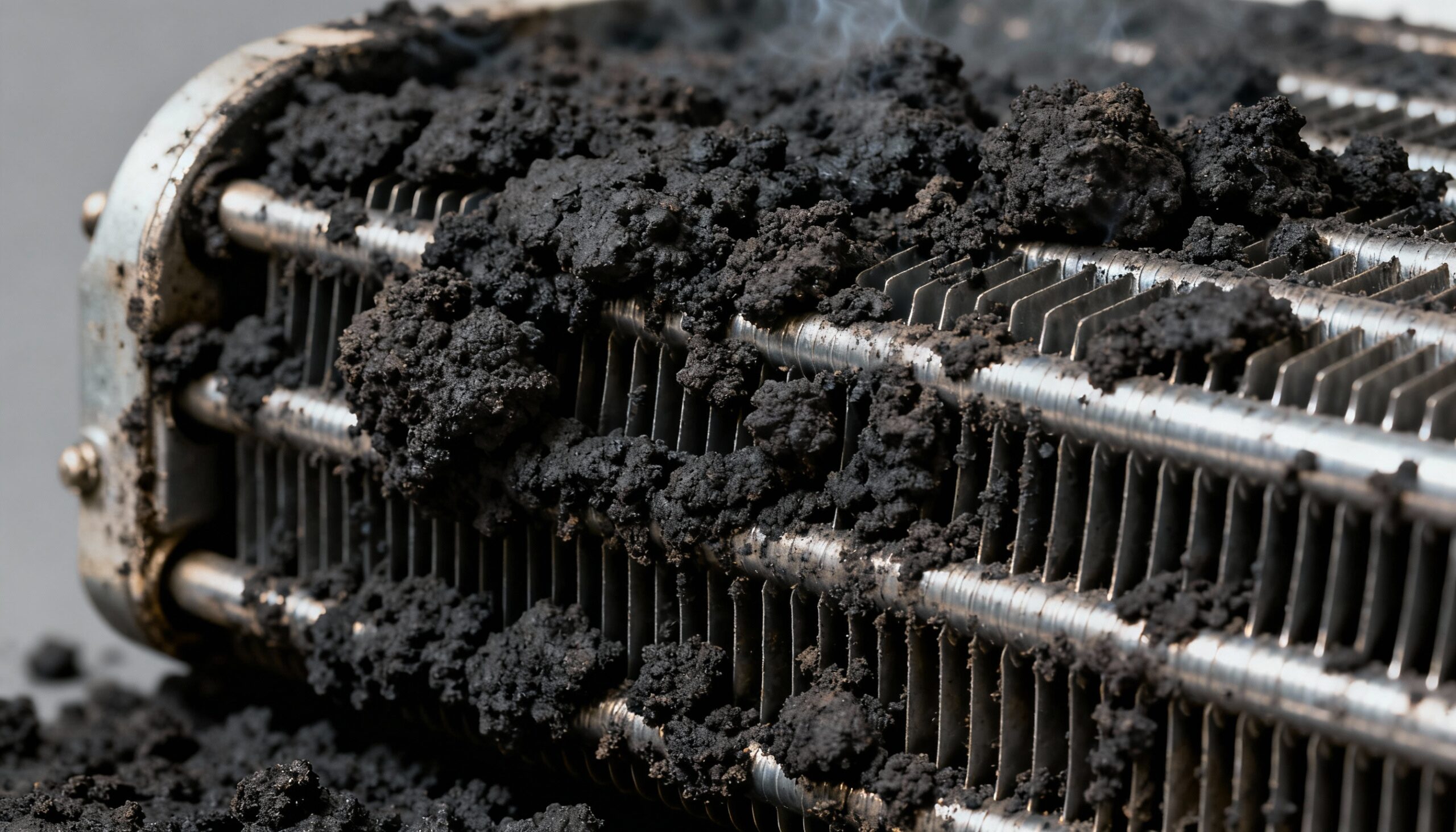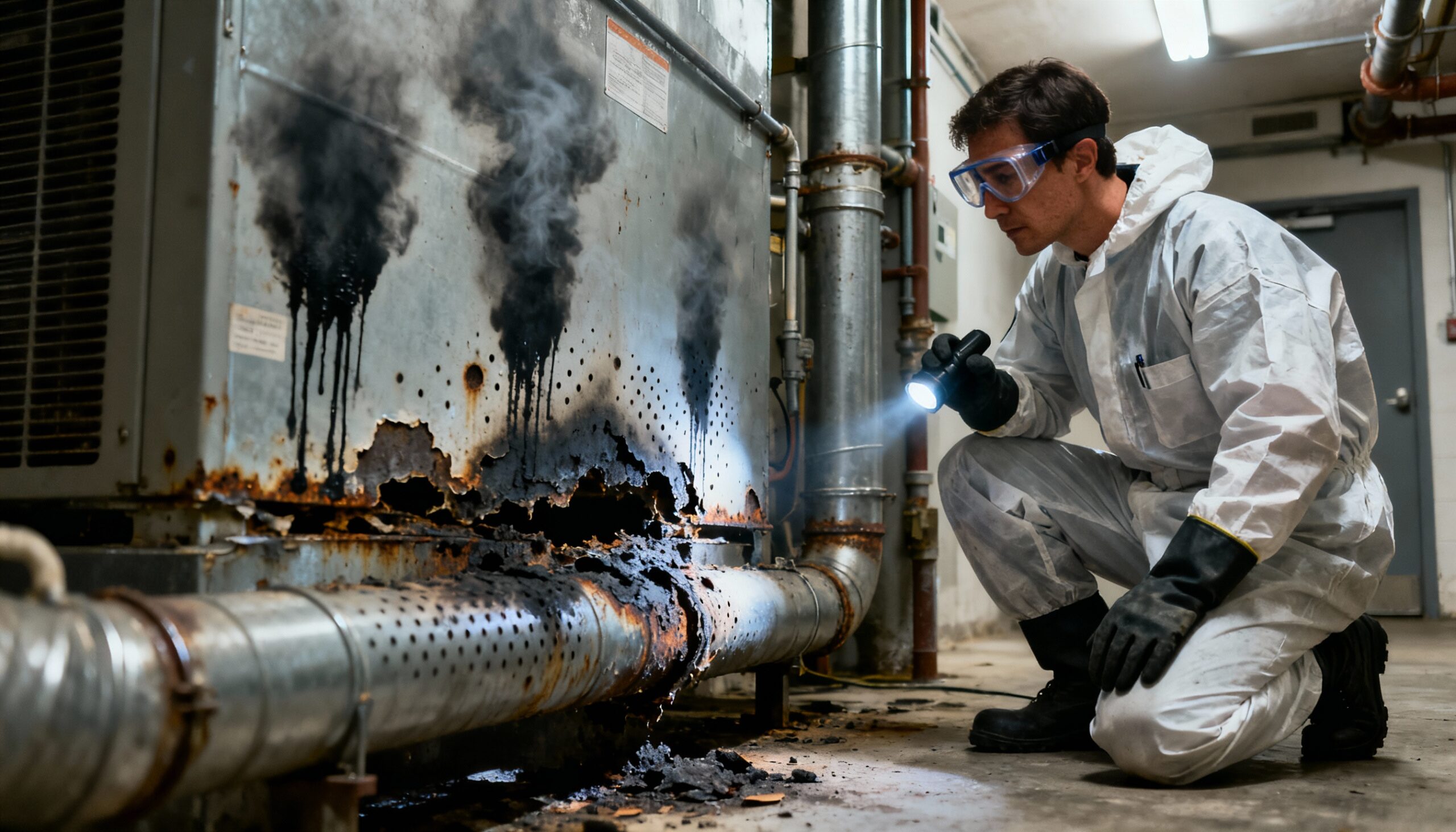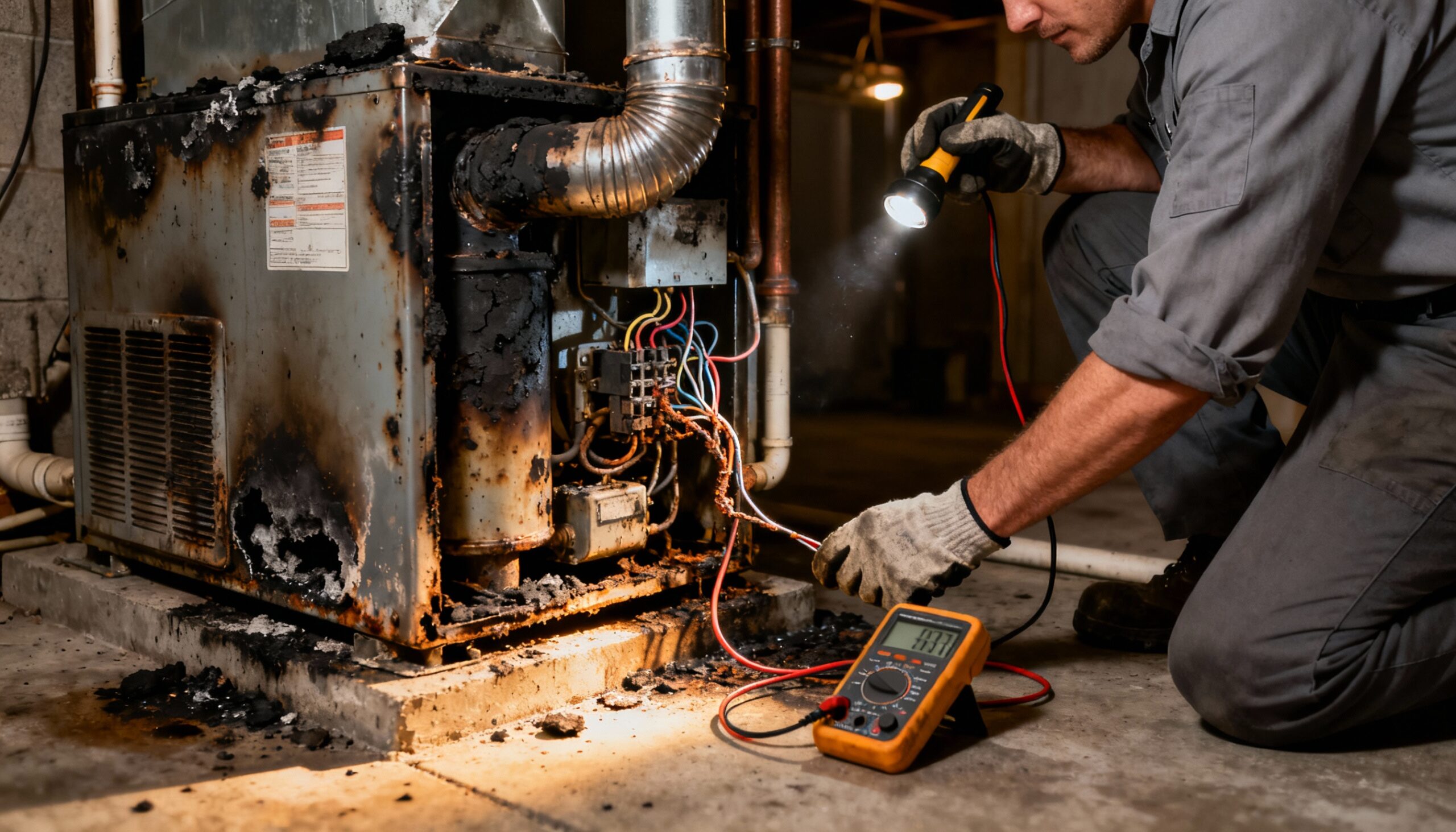Understanding Smoke Damage in HVAC Systems
Smoke damage HVAC systems experience is fundamentally different from surface smoke damage on walls or furniture. During a fire event, your HVAC system becomes a distribution network for smoke particles, corrosive gases, and toxic residues. Even if the fire never reaches the mechanical equipment directly, the system pulls contaminated air through return vents, pushing it through filters, coils, ductwork, and eventually into every room of your property. Assessing smoke damage HVAC contamination requires understanding how different fire types affect system components.
The composition of smoke determines the severity of damage. Protein-based smoke from kitchen fires creates sticky, pungent residues that are particularly difficult to remove. Synthetic smoke from burning plastics, electronics, or modern furnishings releases acidic compounds that corrode metal components and degrade rubber seals. These contaminants don’t simply sit on surfaces—they penetrate porous materials, bond with oils and moisture, and create corrosive environments that accelerate component failure.
Types of Smoke Contamination
Different fire sources create distinct contamination challenges for air system restoration:
| Smoke Type | Common Source | Contamination Characteristics | Restoration Difficulty |
|---|---|---|---|
| Wet Smoke | Smoldering fires, rubber, plastics | Sticky, pungent residue; strong odor; difficult to clean | High |
| Dry Smoke | Fast-burning fires, paper, wood | Powdery, easier to clean; less odor penetration | Moderate |
| Protein Smoke | Kitchen fires, organic materials | Nearly invisible but strong odor; discolors surfaces | High |
| Fuel/Oil Smoke | Petroleum products, furnaces | Strong odor, thick residue, difficult removal | Very High |

⚠️ Important: Never operate your HVAC system immediately after a fire without professional fire and smoke damage assessment. Running contaminated equipment spreads smoke particles throughout your property and can cause permanent damage to sensitive components.

How Fire Damages HVAC Components
Understanding which components suffer the most severe fire damaged HVAC effects is crucial for making informed restoration decisions. Each part of your system responds differently to smoke exposure, with varying potential for successful cleaning versus mandatory replacement.
Ductwork and Ventilation
Your ductwork acts as the primary pathway for smoke distribution during a fire. Metal ducts develop acidic residue coatings that corrode from the inside out, while flexible ducts with inner fabric linings absorb smoke particles that become nearly impossible to fully remove. Insulated ductwork presents particular challenges, as porous insulation materials trap contamination deep within their structure. Addressing smoke damage HVAC ductwork requires specialized equipment and techniques.
Professional HVAC smoke cleaning can restore metal ductwork in many cases through specialized techniques including negative air pressure cleaning, HEPA vacuuming, and chemical treatment. However, flexible ducts and heavily insulated sections typically require complete replacement to ensure safe air quality. In cases where smoke exposure has created moisture problems, mold remediation services may also be necessary.
Air Handlers and Blower Assemblies
The air handler contains your system’s blower motor, which draws air through the return side and pushes it through the supply side. Smoke exposure coats motor windings with acidic residues that accelerate corrosion and eventual motor failure. The blower wheel itself collects particulate matter that creates imbalance and noise during operation.
Motor bearings are particularly vulnerable to smoke contamination. Acidic particles penetrate lubricants, creating grinding surfaces that dramatically shorten motor lifespan. While external cleaning can remove surface contamination, internal motor damage often necessitates complete motor replacement.
Evaporator and Condenser Coils
Cooling coils feature thousands of thin aluminum fins with minimal spacing designed to maximize heat transfer. These fins trap smoke particles and create sticky surfaces that restrict airflow and reduce efficiency. The copper refrigerant lines running through these coils are also susceptible to acid corrosion, which can lead to refrigerant leaks. Smoke damage HVAC coils often show the most visible contamination signs.
Professional coil cleaning using specialized detergents and pressure washing can restore moderately affected coils. However, severe contamination that has caused fin corrosion or refrigerant line damage requires coil replacement to maintain system efficiency and prevent future failures.
Control Boards and Electrical Components
Modern HVAC systems rely on sensitive electronic control boards that regulate everything from temperature control to system diagnostics. Smoke creates conductive pathways across circuit board surfaces, causing electrical shorts and erratic system behavior. Corrosive residues also attack solder joints and connector pins, leading to intermittent failures that are difficult to diagnose.
Electrical components typically cannot be effectively cleaned and restored. Even if temporarily operational after surface cleaning, smoke-contaminated control boards often fail within weeks or months as internal corrosion progresses. While your HVAC system is being addressed, you may also need contents cleaning and restoration services for smoke-damaged belongings throughout your property.
💡 Pro Tip: Document all smoke damage thoroughly with photographs before any cleaning begins. This documentation is essential for insurance claims and helps restoration professionals develop comprehensive treatment plans.
Assessment Criteria for Smoke Damage HVAC Systems: Clean or Replace?
The decision between HVAC smoke cleaning and replacement depends on multiple factors that restoration professionals evaluate during initial assessment. When dealing with smoke damage HVAC equipment, no single criterion determines the outcome—instead, specialists consider the complete picture of contamination severity, system age, damage extent, and safety implications.
Contamination Severity Levels
Light contamination: Smoke exposure limited to surface deposits on accessible components, with no evidence of corrosion or penetration into porous materials. Systems with light contamination typically respond well to professional cleaning, with restoration success rates above 85%.
Moderate contamination: Visible residue on most surfaces with odor penetration and early corrosion signs. Moderate cases require extensive cleaning with component-specific treatments. Success depends heavily on system age and construction materials, with newer systems showing better restoration outcomes.
Severe contamination: Heavy residue buildup with advanced corrosion, structural damage to components, or prolonged exposure to intense smoke. Severe contamination generally necessitates complete system replacement, as cleaning cannot restore safe operation or air quality. When facing severe damage, immediate 24-hour emergency restoration services can prevent further deterioration.

System Age and Condition
A fire damaged HVAC system that was already approaching the end of its service life rarely justifies expensive restoration efforts. Systems older than 12-15 years with smoke damage HVAC contamination often make better financial sense to replace entirely, as restoration costs combined with limited remaining lifespan create poor value propositions.
Conversely, systems less than five years old with moderate damage often warrant aggressive restoration attempts. The remaining equipment lifespan and potential warranty considerations make professional cleaning and component replacement more economically justifiable.
| Assessment Factor | Favors Cleaning | Favors Replacement |
|---|---|---|
| System Age | Less than 7 years old | More than 12 years old |
| Contamination | Light to moderate surface residue | Severe penetration, heavy corrosion |
| Component Damage | Primarily ductwork and coils | Motor, compressor, or control damage |
| Odor Severity | Dissipates with cleaning | Persistent despite treatment |
| Fire Proximity | Smoke exposure only | Direct flame contact or heat damage |

Professional HVAC Smoke Cleaning Process
When assessment determines that air system restoration is viable, certified restoration specialists follow systematic protocols designed to remove contamination while preserving system integrity. This process requires specialized equipment, cleaning agents, and expertise that goes far beyond standard HVAC maintenance.
Step 1: System Isolation and Protection
Before any cleaning begins, technicians isolate the HVAC system to prevent contamination spread. They seal supply registers and return vents, protecting clean areas from residue dislodged during the cleaning process. The system remains powered off throughout initial cleaning phases to prevent accidental circulation of disturbed particles.
Step 2: Component Disassembly and Access
Thorough HVAC smoke cleaning requires access to internal components that aren’t reachable during standard maintenance. Technicians remove access panels, blower assemblies, and evaporator coil covers to expose all contaminated surfaces. Properly addressing smoke damage HVAC issues means accessing every component where contamination may hide. Ductwork may require additional access points cut for cleaning equipment insertion.
Step 3: Dry Contamination Removal
Initial cleaning focuses on removing loose particulate matter using HEPA-filtered vacuum systems. These industrial vacuums capture microscopic particles without releasing them back into the air. Brush attachments gently agitate surfaces to release embedded particles from fins, vents, and textured surfaces.

Step 4: Chemical Treatment and Deodorization
After dry cleaning, specialists apply chemical treatments specifically formulated for smoke residue removal. These agents break down acidic compounds and lift sticky residues from metal surfaces. Separate treatments address odor molecules trapped in porous materials using oxidizing agents or encapsulating compounds that neutralize odor sources rather than simply masking them. For properties with additional contamination concerns, biohazard cleanup services may be required alongside HVAC restoration.
Step 5: Ductwork Restoration
Duct cleaning for fire damaged HVAC systems goes beyond standard cleaning. Technicians use negative air machines to create airflow while introducing HEPA-filtered air pressure at access points. This technique dislodges residue while immediately capturing it before recirculation. Interior duct surfaces may receive fog or mist treatments to neutralize remaining odors.
Step 6: Component Testing and Verification
After cleaning, technicians reassemble the system and conduct operational testing. They monitor for unusual sounds, vibrations, or odors during startup. Air quality testing measures particulate levels and confirms that the system distributes clean air. If testing reveals persistent contamination, additional treatment cycles or component replacement becomes necessary.
🏠 Home Tip: Replace all air filters immediately after professional cleaning and again after the first week of operation. These initial filters capture remaining particles that cleaning may have missed, preventing recirculation through your living spaces.
When Smoke Damage HVAC Replacement Is the Only Option
Certain damage patterns make smoke damage HVAC replacement unavoidable, regardless of system age or restoration investment willingness. Recognizing these situations early prevents wasted restoration attempts and accelerates your return to safe indoor air quality.
Direct Fire Exposure
Systems that experienced direct flame contact or extreme heat exposure suffer damage that extends beyond surface contamination. Wiring insulation melts, refrigerant lines weaken, and metal components experience structural changes that compromise long-term reliability. Even if the smoke damage HVAC system appears operational after cleaning, hidden damage will manifest as premature failures.
Compressor Contamination
The compressor represents your system’s most expensive single component. If smoke penetrated the sealed refrigeration system, contaminating the compressor oil and internal surfaces, replacement becomes inevitable. Cleaning cannot access these sealed components, and contaminated oil causes rapid compressor failure through bearing damage and acid formation.
Persistent Odor After Treatment
If professional cleaning fails to eliminate smoke odors, or if odors return after initial dissipation, the contamination has likely penetrated materials beyond cleaning reach. Continuing to operate a system that distributes smoke odors creates health concerns and reduces indoor air quality below acceptable standards. In cases of extensive fire damage requiring property security, residential board-up services protect your property during the restoration process.
Extensive Electrical Damage
When control boards, wiring harnesses, and safety controls show corrosion damage, the cumulative replacement expense often exceeds new system installation. Replacing individual electrical components provides no guarantee against additional failures from contamination of adjacent parts.
Economic Considerations
If restoration expenses approach 50% of replacement system value, especially for systems beyond their midpoint service life, replacement typically provides better long-term value. This calculation should factor in energy efficiency improvements available with new equipment and potential insurance coverage differences between restoration and replacement.
Prevention and Maintenance After Smoke Damage HVAC Restoration
Whether you’ve invested in professional air system restoration or installed a replacement system, protecting that investment requires diligent maintenance and monitoring. Systems that have experienced smoke damage HVAC contamination remain more vulnerable to future problems, making preventive care especially important.
Enhanced Filtration
Upgrade to higher-efficiency filters (MERV 11-13 rating) to capture residual particles that standard filters miss. These filters require more frequent replacement—monthly for the first three months after restoration, then quarterly ongoing. The additional filtration investment pays dividends through improved air quality and reduced particle accumulation on sensitive components.
Quarterly Professional Inspections
Schedule professional HVAC inspections every three months for the first year after restoration or replacement. These inspections identify emerging problems early, when correction remains simple and inexpensive. Technicians can monitor for odor return, unusual wear patterns, or performance degradation that might indicate incomplete restoration.
Air Quality Monitoring
Consider installing air quality monitors that detect particulate matter and volatile organic compounds. These devices provide early warning if contamination issues resurface, allowing immediate intervention before health impacts occur or property-wide recontamination develops.
💡 Pro Tip: Keep detailed maintenance records after any fire-related HVAC work. These records prove valuable for future insurance claims, home sales, or warranty issues, demonstrating proper care and restoration procedures were followed.
Frequently Asked Questions
How long does professional HVAC smoke cleaning take?
Complete HVAC smoke cleaning typically requires 1-3 days depending on system size and contamination severity. This includes initial assessment, component disassembly, cleaning treatments, drying time, reassembly, and verification testing. Complex commercial systems may require longer timeframes for thorough restoration.
Can I clean smoke damage from my HVAC system myself?
DIY cleaning is not recommended for fire damaged HVAC systems. Surface cleaning accessible areas doesn’t address contamination deep within ductwork, coils, and sealed components. Improper cleaning can actually spread contamination or damage sensitive parts. Professional restoration uses specialized equipment and chemicals not available to homeowners, and includes verification testing to ensure safe operation.
Will my insurance cover HVAC smoke damage restoration?
Most homeowners insurance policies cover smoke damage HVAC restoration as part of fire damage claims. Coverage typically includes both professional cleaning and replacement if necessary. Document all damage thoroughly with photographs, obtain multiple professional assessments, and work directly with your insurance adjuster to determine covered services and reimbursement amounts.
How can I tell if smoke damage is affecting my HVAC system?
Warning signs of smoke damage HVAC problems include persistent smoke odors when the system runs, visible soot around vents, reduced airflow, unusual noises, and family members experiencing respiratory irritation. Even without obvious symptoms, any fire event warrants professional HVAC assessment, as internal contamination may not be immediately apparent but still poses health risks and equipment damage.
What’s the typical lifespan of a cleaned HVAC system after smoke damage?
Properly restored systems can operate for their remaining expected lifespan if contamination was light to moderate and cleaning was thorough. However, systems typically lose 2-4 years of service life compared to never-damaged equipment due to accelerated component wear from even minor residual contamination. Severely damaged systems that undergo partial restoration may only last 1-3 additional years before major component failures occur.
Should I replace my HVAC filter before or after professional cleaning?
Remove and discard contaminated filters before professional cleaning begins, but don’t install new filters until cleaning is complete. Technicians need unobstructed airflow during the cleaning process. After restoration, install a new high-efficiency filter and plan to replace it again after one week of operation to capture any residual particles that working dislodges.

